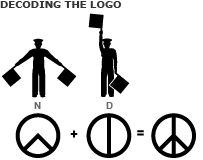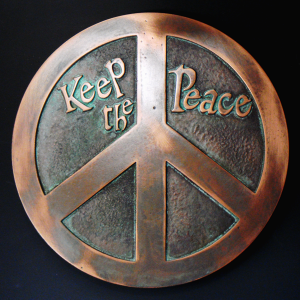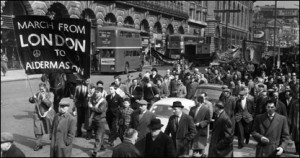Here at Atlas Signs and Plaques our business is signs. We make signs so that people can understand an idea (even if it is as simple as indicating an address) without the need to verbally express it. As such, we are interested in all kinds of signs: big or small, grand or infantile. The sign I’m looking at today is a very, very famous one. You’ve seen it in your high school history books. You’ve seen it on cars, posters, vans, and billboards. If you lived in the late 60’s then you saw it everywhere. I’m talking of course, about the peace sign. The history of the peace sign can be traced back to 1958 during the acceleration of worldwide nuclear arms.
The peace sign was created by Gerald Herbert Holton on February 21, 1958. Holton was a dedicated peacemaker who, disgusted by the USA’s usage of atomic weapons in WWII, and the proliferation of worldwide nuclear weapons, joined the Direct Action against Nuclear War Committee (DAC) —an initiative dedicated to containing worldwide nuclear strength. Holton (who was a gifted designer) created the symbol for the DAC with a duality of connotations in mind
His first message was to relay the hopelessness of mankind’s continued existence should nuclear weapons adopt regular usage. To convey this message, Holton says: “I drew myself, the representative of an individual in despair, with hands outstretched outwards and downwards in the manner of [an inverted] Goya’s peasant before firing squad”.

The second message that the sign communicates is through a juxtaposition of letters. The peace sign is simply an N, for nuclear, superimposed atop a D, for disarmament, surrounded by a complete circle. I always thought that the peace sign looked like a birds-eye view of a jet, but maybe that’s just me…
The symbol was first used for the DAC’s anti-nuclear march from London to England’s nuclear factory in Aldermaston. DAC committee members reasoned that public opinion of the marchers’ cause would be better understood if a simple, universal symbol reflecting their beliefs could be provided. During the march, the symbol was displayed prominently on banners, flags, and signs as the protestors made their way to Aldermaston.
At this point in the signs’ history, it only symbolized a rejection of nuclear arms; the peace connotation only evolved when the sign reached the USA.
American civil rights activist Bayard Rustin attended the DAC’s anti-nuclear march and brought the sign across the Atlantic where it was soon displayed in civil rights marches not as a means to protest nuclear arms, but as a Ghandi-ish, pacifistic symbol promoting passive aggressive peace.
Eventually the peace sign was adopted as a sort of banner, an icon and logo, for the hippie movement—a connotation that it still relevant today. But it has not lost its core meaning. I believe the core meaning is that all life is sacred and worth defending whether that means fighting against the temptations of nuclear arms, fighting for freedom against tyranny, or fighting for the ideal of peace.


